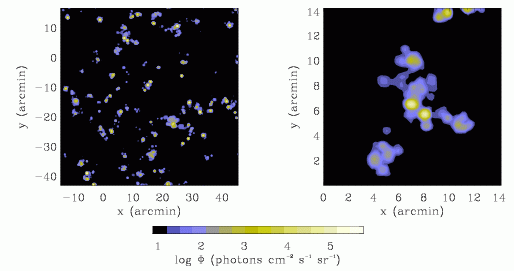
Home
Research
The
Group
Publications
Talks
Teaching
Links
| |
Research Interests:
Galaxy Feedback
Possibly the most important, but least well-understood, aspect of
galaxy formation is the role of feedback on both the galaxy itself and
its environs and neighbors. This feedback can take many aspects:

Winds and Metal Enrichment: The IGM is enriched with heavy
elements via winds from star-forming galaxies. I am mostly concerned
with studying observable consequences of these processes. For
example, the images at the right show emission from the local universe
in a UV doublet of OVI. Emission comes from warm (T~100,000 K),
highly enriched gas - galactic winds and the centers of galaxy groups,
for the most part. Observations of this line therefore provide
information on the history of galactic winds. Absorption lines from
similar transitions have already provided some information on the
enrichment pattern; when these studies are extended to
higher-redshift, they will tell us about the earliest IGM enrichment,
which is crucial for understanding the first galaxies.
Photoheating: During reionization, the IGM is rapidly
heated to T~10,000 K. The increased thermal pressure has important
consequences for structure formation, because it prevents gsa from
accreting onto galaxies as well as filaments and other gas clumps.
The dynamical effects of this sudden heating, as well as its effects
on the geometry of reionization, remain poorly understood.
Other Radiation Backgrounds: Before reionization, other
radiation backgrounds can also affect the IGM and galaxy formation.
X-rays heat the IGM, reducing clumping. Ultraviolet photons
destroy molecular hydrogen, but X-rays catalyze its formation. The
complicated net effects of these mechanisms must still be sorted out.
|


